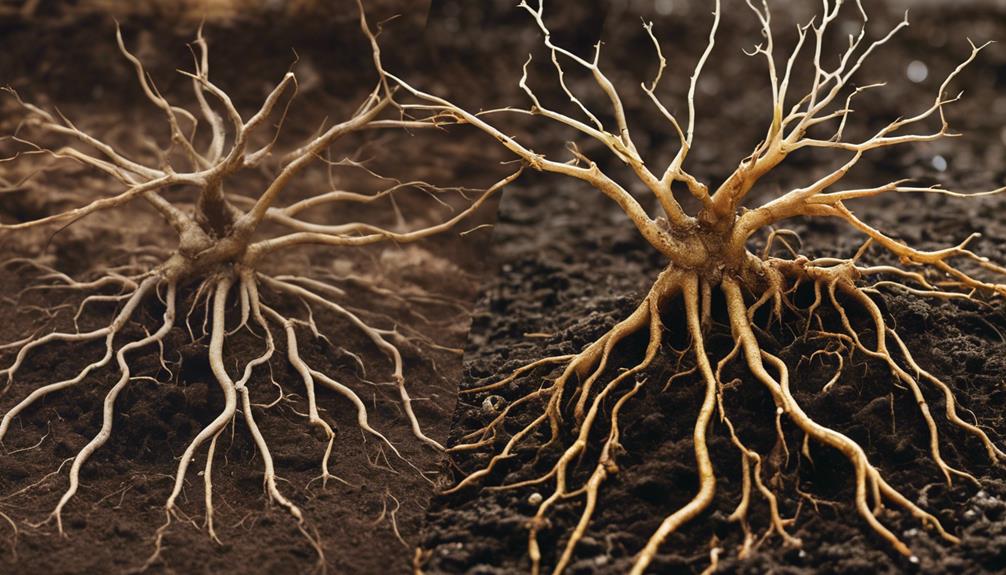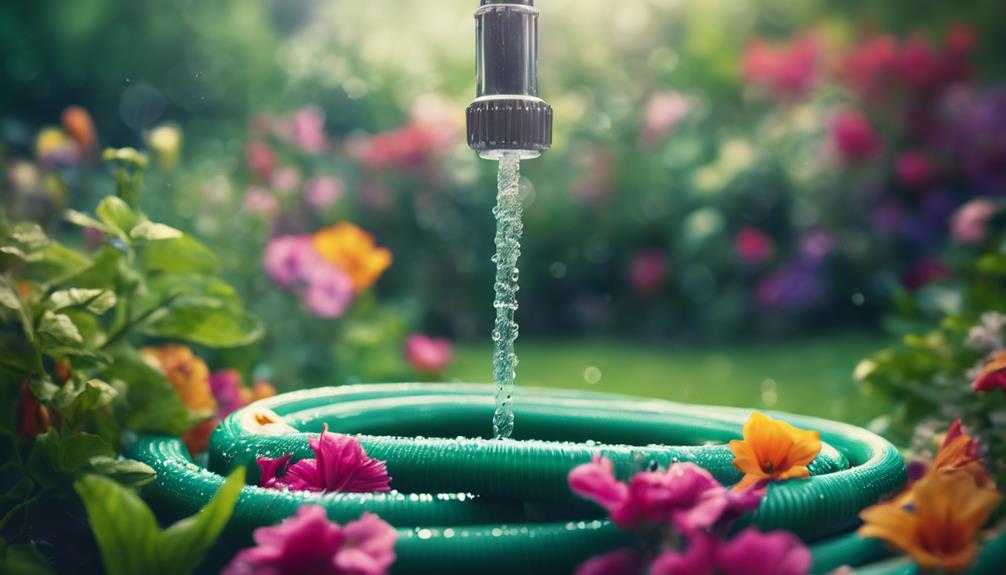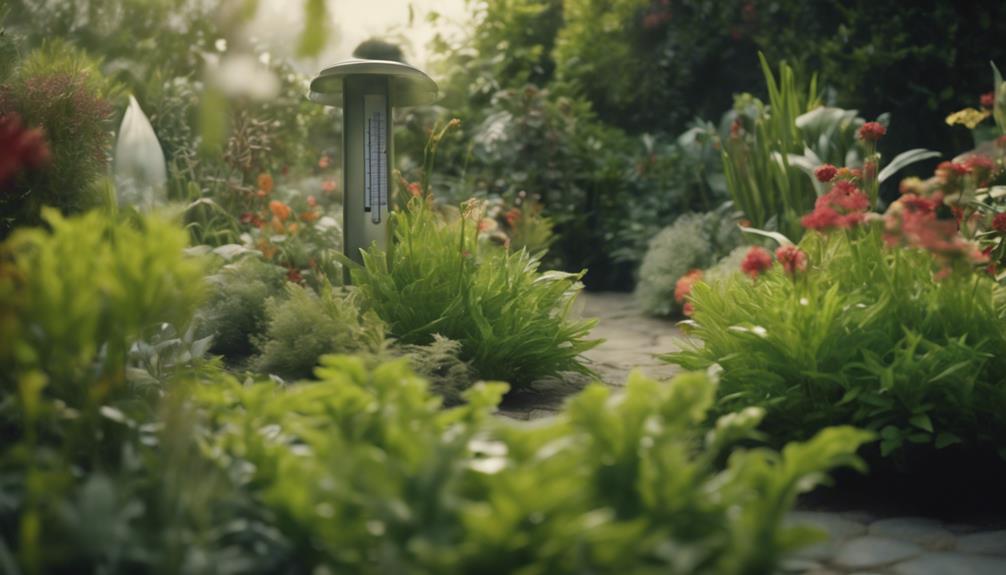You'll be surprised to learn that the ideal water temperature for a healthy garden is not just a matter of personal preference, but rather a precise range of 20-22°C (68-71.6°F) that can make or break plant growth and health. This temperature range allows for peak plant growth, healthy root development, and efficient nutrient uptake. Maintaining this range is crucial to avoid stressing your plants, as temperature fluctuations can lead to root rot, stunted growth, and even plant death. By understanding the importance of perfect water temperature, you'll discover the secrets to a thriving garden.
Table of Contents
Key Takeaways
- The ideal water temperature for peak plant growth and health is between 20-22°C (68-71.6°F) throughout the growing season.
- Water temperature affects nutrient uptake, with ideal temperatures triggering the pump mechanism in roots and increasing water uptake efficiency.
- Temperature extremes, such as below 10°C or above 30°C, can cause root damage and reduce plant growth, making it essential to maintain optimal temperatures.
- Using warm water for irrigation, typically between 68°F and 72°F, promotes healthy root growth, increases nutrient uptake, and supports overall plant development.
- Regular monitoring and adjusting of water temperature is essential to prevent temperature fluctuations that can stress or kill plants, especially in hydroponic systems.
Water Temperature and Plant Growth
When you water your plants, the temperature of the water can profoundly impact their growth and overall health, with the ideal range lying between 20-22°C (68-71.6°F) for peak results.
This perfect water temperature reduces plant stress and boosts overall health.
If the water is too hot or cold, it can have detrimental effects. For instance, temperatures above 25°C (77°F) can lead to root rot, while those below 15°C (59°F) can slow down plant growth.
In hydroponic systems, the suitable water temperature ranges from 18°C to 25°C (65°F to 77°F), promoting healthy root growth and nutrient uptake.
The water temperature also affects the availability of nutrients in the substrate.
When the temperature is ideal, it triggers the pump mechanism in roots, allowing for efficient nutrient uptake.
Ideal Temperature Ranges Explained
You'll want to fine-tune your irrigation system to deliver water within the ideal temperature ranges, as even slight deviations can profoundly impact plant growth and health.
The best water temperature for irrigation is approximately 20-22°C (68-71.6°F) throughout the growing season, which reduces plant stress and increases plant health.
For hydroponics, the ideal water temperature is between 18°C and 25°C (65°F and 77°F), with some plants preferring temperatures at the higher or lower end of this range.
Aeroponics and aquaponics systems require a narrower temperature range of 20-27°C (68-81°F) and 20-28°C (68-82°F) respectively, to maintain perfect plant growth and health.
Drip irrigation systems can operate effectively with water temperatures between 23°C ± 2.1°C (73.4°F ± 2.1°F), which allows for flexibility in temperature control.
Effects of Temperature on Roots

As you explore the effects of temperature on roots, you'll find that the ideal water temperature greatly impacts root health.
You'll notice that even slight deviations from the perfect range can substantially affect root growth and function, ultimately influencing water uptake efficiency.
Root Temperature Impact
Root temperature has a profound impact on plant growth, with ideal temperatures ranging from 15°C to 25°C, depending on the plant species, to facilitate healthy root development and nutrient uptake. As you water your plants, the temperature of the water affects the roots' ability to absorb essential nutrients. If the water temperature is too low or too high, it can impede root growth and overall plant development.
Temperature extremes: Water temperatures below 10°C or above 30°C can cause root damage, reducing plant growth and increasing susceptibility to disease.
Optimal temperature range: Most plants thrive when the root temperature is between 15°C and 25°C, allowing for efficient nutrient uptake and healthy root development.
Species-specific requirements: Some plants, like tropical species, require higher water temperatures, while others, like lettuce, prefer cooler temperatures. Research the specific needs of your plants to ensure optimal growth.
Water Uptake Efficiency
When water temperature aligns with the ideal range for your plant species, it boosts water uptake efficiency, allowing roots to absorb nutrients more effectively.
This means you'll see healthier, more vibrant plants as a result. As you provide ideal water temperature, you're giving your roots the green light to function at their best. Water uptake efficiency is vital, as it directly affects how well your plants absorb the nutrients they need to thrive.
When water temperature is in the perfect range, dissolved oxygen levels increase, which in turn enhances water uptake efficiency.
This allows your roots to take in the nutrient solution more effectively, promoting overall plant health. On the other hand, water that's too hot or cold can hinder this process, leading to reduced water uptake efficiency and, ultimately, stunted plant growth.
Oxygen Levels and Water Temperature
Maintaining ideal water temperature is essential because it directly impacts the oxygen levels in the water, which in turn affects the health of your plants.
You see, water temperature has a direct correlation with the amount of dissolved oxygen in the water. As the temperature increases, the solubility of oxygen decreases, which can lead to reduced oxygen levels.
This is critical because oxygen levels below 3 milligrams per liter can lead to root rot and other plant health issues.
At 68°F (20°C), water contains approximately 8.3 milligrams of dissolved oxygen per liter, which is ideal for healthy plant growth.
A 10°F (5.6°C) increase in temperature results in a 2-3 milligram per liter decrease in dissolved oxygen.
Aerating the water or using an oxygen supplement can help increase dissolved oxygen levels if the water temperature is too high.
Cold Water Vs Warm Water Benefits

When you water your plants, you're not just providing them with a drink – you're also affecting their roots, nutrient uptake, and overall health.
You'll want to choose the right water temperature to prevent chilly shock, boost root growth, and enhance nutrient uptake.
Chilly Shock Prevention
Watering your plants with cold water can be a recipe for disaster, as it can cause chilly shock, a condition that can lead to root rot, stunted growth, and even plant death. This is especially true for warm-season crops like tomatoes and peppers.
To prevent chilly shock, it's essential to use warm water, typically between 68°F and 72°F, which promotes healthy root growth, increases nutrient uptake, and supports overall plant development.
Cold water can lower soil temperature, slowing down microbial activity and reducing nutrient availability.
Warm water increases oxygen solubility, making it more available to roots, which is essential for healthy root function and plant growth.
Using warm water for irrigation can reduce transplant shock, as it mimics the soil temperature roots are accustomed to, making the transition to a new environment less stressful for the plant.
Root Growth Boost
By using warm water, you can substantially boost root growth, as it stimulates roots to produce more hair roots, which in turn increases the plant's ability to absorb nutrients and water.
This ideal water temperature encourages healthy root development, allowing your plant to thrive. As a result, you'll notice improved overall plant health and vigor.
Warm water, typically between 65°F and 75°F (18°C and 24°C), is ideal for root growth. This temperature range allows for maximum absorption of water and nutrients, promoting a strong and extensive root system.
Nutrient Uptake Enhancement
The ideal water temperature plays a significant role in enhancing nutrient uptake, with both cold and warm water having distinct benefits that can substantially impact your plant's growth and development. When it comes to nutrient uptake, the perfect water temperature is essential, as it affects the solubility and availability of essential micronutrients.
Cold water benefits: Improves the uptake of micronutrients like iron and zinc, which are essential for healthy plant growth. Cold water also increases the availability of oxygen, promoting healthy root development.
Warm water benefits: Enhances the uptake of macronutrients like nitrogen, phosphorus, and potassium, which are fundamental for plant growth and development. Warm water also increases the activity of beneficial microorganisms, promoting a healthy soil ecosystem.
Plants require a temperature range of 65°F to 75°F (18°C to 24°C) for efficient nutrient uptake. This temperature range allows for the efficient uptake of both micronutrients and macronutrients, promoting healthy plant growth and development.
Managing Temperature Fluctuations
Measuring and controlling water temperature is essential to prevent temperature fluctuations that can stress or kill plants, and a thermometer is an indispensable tool in this process.
You need to monitor water temperature regularly to verify it's within the ideal range of 20-22°C (68-71.6°F) throughout the growing season. This temperature range reduces plant stress and increases plant health.
If the water temperature exceeds 25°C (77°F), it can cause root rot, while temperatures below 20°C (68°F) can be lethal to plants.
To manage temperature fluctuations, you can use a water chiller to cool the water, especially during hot weather.
Covering your pond can also help reduce the impact of air temperature and solar radiation on the water temperature. Additionally, the size and depth of your pond, as well as rainfall, influence its cooling capacity.
By taking these measures, you can maintain a stable water temperature, which is essential for your plants' health.
Maintaining Optimal Water Temperature

To maintain ideal water temperature, you should prioritize monitoring and adjusting it regularly, as even slight deviations from the perfect range can greatly impact plant health.
Maintaining ideal water temperature is vital, especially in hydroponic systems, where plants rely solely on water for their growth.
Use a thermometer to measure water temperature and adjust it accordingly to promote healthy plant growth.
Install temperature sensors in your pond to monitor water temperature and track where to take the water from, maintaining it within the required temperature range.
Consider using a heat exchanger or chiller to cool the water if necessary, especially during hot weather conditions.
Temperature Control for Hydroponics
When it comes to hydroponic systems, controlling water temperature is vital, as even slight fluctuations can substantially impact plant growth, nutrient uptake, and overall system health.
You want to maintain the ideal water temperature for hydroponics, which is around 20-22°C (68-71.6°F), to reduce plant stress and increase plant health. Temperatures above 25°C (77°F) can lead to root rot, while those below 20°C (68°F) can hinder nutrient uptake and absorption.
To maintain ideal conditions, you can use heaters, chillers, and heat exchangers to regulate water temperature.
Regular monitoring of water temperature is also essential, as fluctuations can lead to disease, nutrient deficiencies, and reduced plant yields.
Frequently Asked Questions
Is It OK to Water Garden in Heat of Day?
When you water in the heat of the day, you risk midday irrigation evaporating quickly, increasing evaporation rates and causing water stress. Instead, consider afternoon soaking to minimize sunlight absorption and maximize absorption by your plants.
Do Plants Grow Better With Warm or Cold Water?
You might be surprised to know that 85% of a plant's energy goes into root development! When you water with warm water, you're boosting water absorption, supporting soil microbes, and enhancing nutrient uptake, which fuels cellular growth, making your plants thrive.
At What Temperature Should You Not Water Outdoor Plants?
You shouldn't water outdoor plants when the temperature is near freezing, as frost damage can occur; instead, consider soil type, rainfall patterns, humidity levels, and sun exposure to determine the best watering schedule for your plants.
What Temperature Water Is Too Hot for Plants?
When you water, beware of scalding risks! Water above 90°F (32°C) can cause water stress, exceeding most plants' temperature tolerance, leading to leaf scorch and cellular damage, so adjust your hose accordingly to avoid harming your beloved greens.
Conclusion
You've got the power to tap into your garden's full potential by mastering the ideal water temperature!
It's like holding the keys to a treasure trove of growth and productivity.
By maintaining the perfect temperature range, you'll be showering your plants with the perfect blend of oxygen, nutrient uptake, and root growth.
So, don't let temperature fluctuations hold you back – take control and watch your garden thrive like never before!

